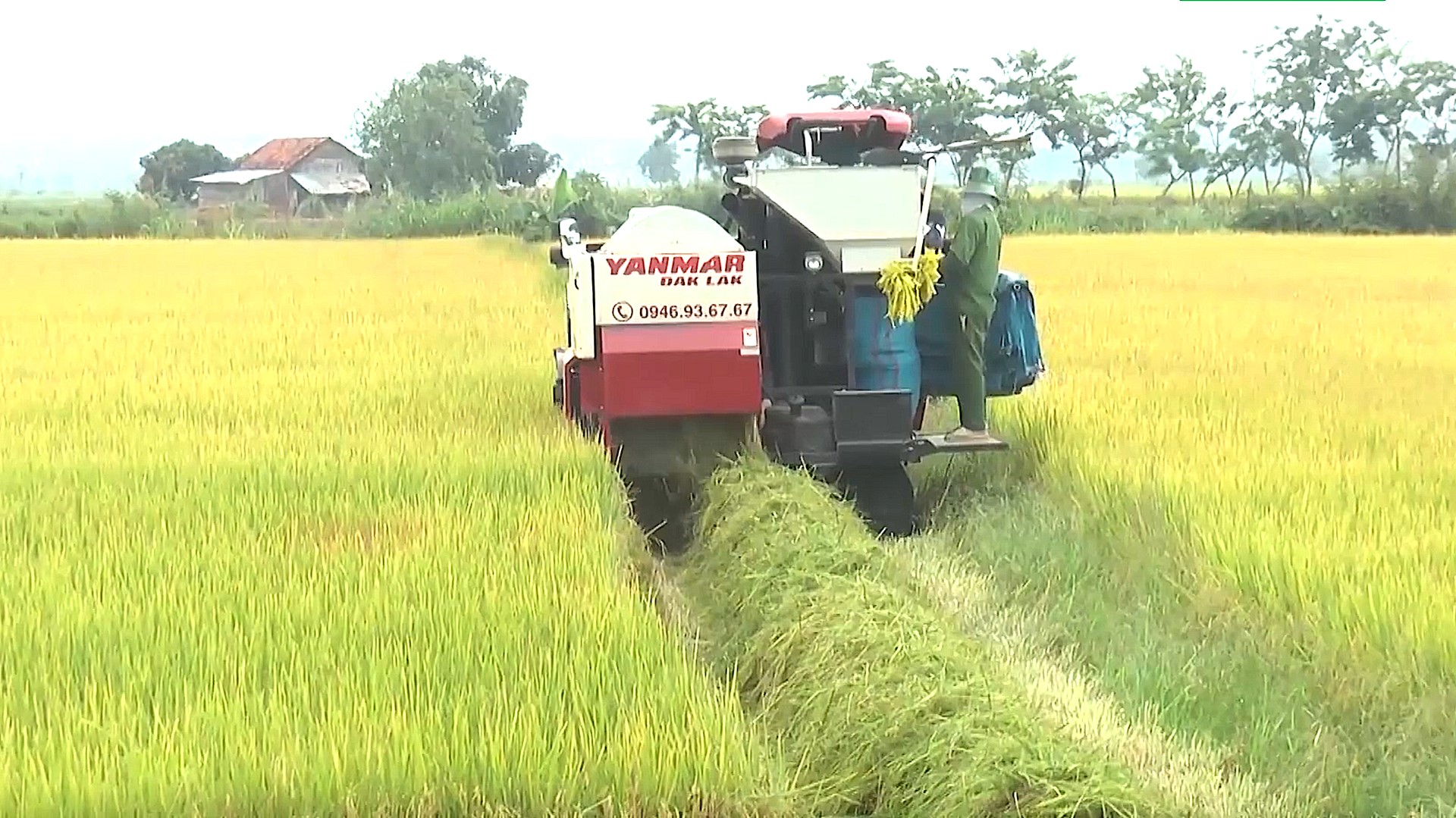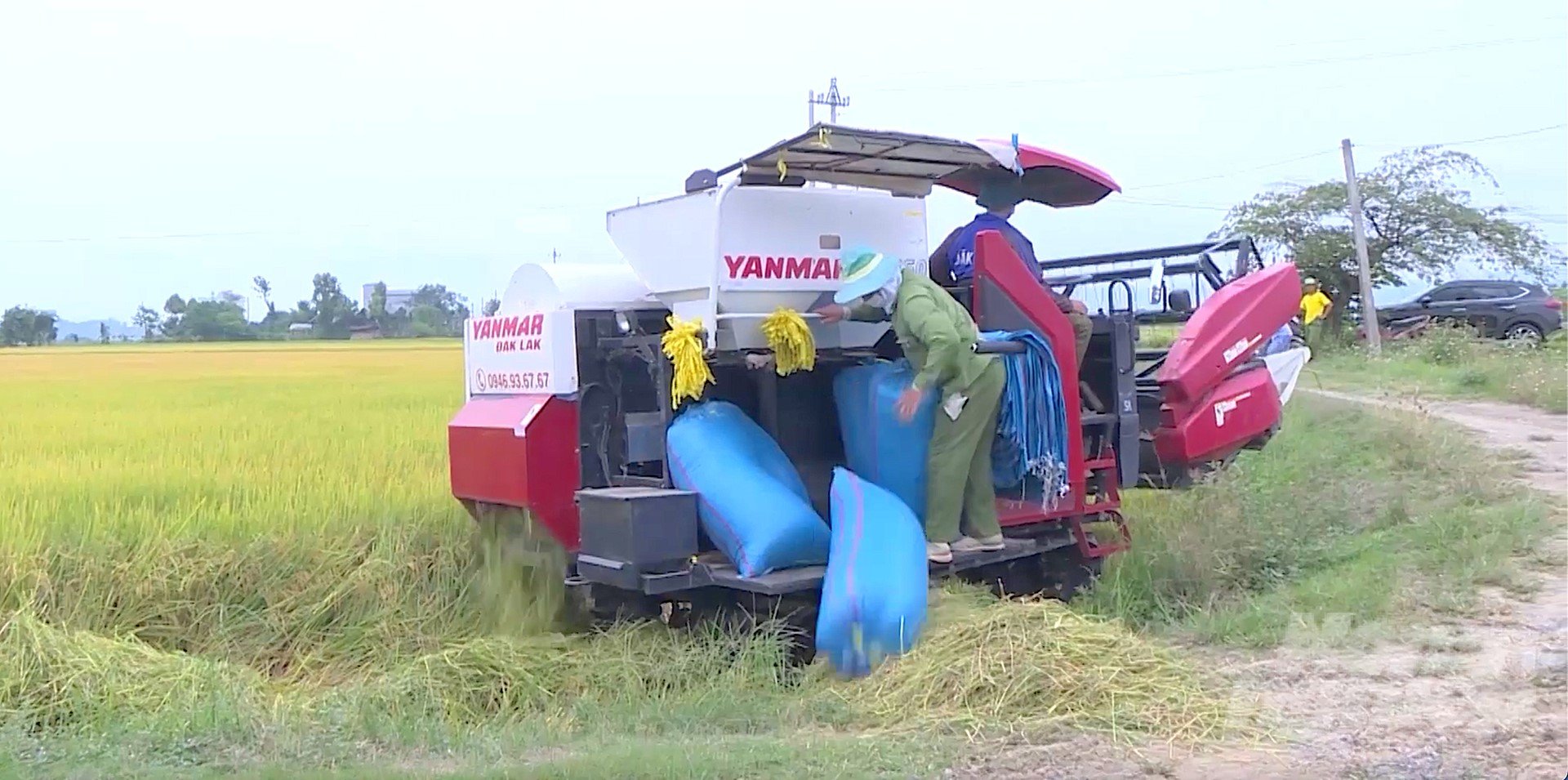June 19, 2025 | 10:23 GMT +7
June 19, 2025 | 10:23 GMT +7
Hotline: 0913.378.918
June 19, 2025 | 10:23 GMT +7
Hotline: 0913.378.918
The rice-growing area of Buon Choah commune, K'rong No district (Dak Nong province), lies at the foot of the dormant Nam Blang volcano.
The people's lives in Buon Choah today are no less than those of the well-off countryside in the lowlands. "Now people here, from ethnic minorities to Kinh migrants, are very good at technology, applying mechanization in farming. They are not as backward as before. Thanks to the ST rice variety, people are getting better. This rice variety grown here has a higher yield than in the plains, reaching 11–12 tons of fresh rice/ha," said Mr. Ho Gam, Chairman of the Farmer's Union of Dak Nong province.

ST rice field of Buon Choah Agricultural Cooperative on the K'rong No River. Photo: Hong Thuy.
Buon Choah commune is a low-lying countryside, lying between the K'rong No River (the Cha River, one of the two branches of the Serepok river flowing backward) and the foot of Nam Blang volcano. Due to the more "unpleasant" weather than other regions, including hot weather with a shortage of water in the dry season and flooding in the rainy season, the cultivation of agricultural plants also seems to be more difficult.
According to Mr. Ho Gam, ST24, and ST25 rice varieties were brought back to grow about ten years ago. After 1-2 crops with a good yield and extremely fragrant and sweet rice, people gradually follow each other to plant. "Buon Choah commune has a total area of over 700ha of wet rice farming, with two crops. In the past, people cultivated according to a traditional and backward method with poor variety, so the efficiency was low and life was always difficult. Only when we transformed to grow ST rice to replace the old varieties did everything really change," he said.
In 2014, K'rong No district established a cooperative group to produce high-quality ST rice, VietGAP, in Buon Choah. In 2020, this group was upgraded to the Buon Choah Agricultural Cooperative. Up to now, the cooperative has 350 member households, cultivating an area of more than 500ha of VietGAP rice with the main rice varieties, including ST24, ST25, etc.
Mr. Trieu Van Truong in Thanh Son Hamlet, a member of the Buon Choah Agricultural Cooperative, said that his family has been living on rice farming for a long time, but due to poor rice varieties and the fact that they do not know how to apply farming processes scientifically and methodically, the yield is very low, just enough to cover the family's needs without surplus. Since planting the ST25 rice variety and participating in the Buon Choah cooperative group, his family's economy has gradually prospered.

The yield of the ST rice variety grown in Buon Choah is even higher than in the Southwest granary. Photo: Hong Thuy.
"My family has 2ha of rice land. Since participating in the cooperative group and then the cooperative, planting the ST rice variety, and applying the processes according to the instructions, my rice yield has reached an average of 11 tons of fresh rice/ha, twice as high as previous times. This is not the highest yield. Some people even harvest more than 12 tons/ha, which is much higher than that of the Central Highlands provinces and even higher than the yield in the Southwest granary.
After deducting costs, I earn an average profit of around VND 30 million/ha for each rice crop. Thus, each year, with two growing crops, I earn more than VND 100 million. My family's life has really changed completely since participating in the high-quality rice growing cooperative," Mr. Truong said, adding that all products are consumed by the cooperative at a price that is always higher than in the market.
Mr. Bui Dinh Kien, Director of the Buon Choah Agricultural Cooperative, said that ST24 and ST25 rice varieties grown in Buon Choah give long, clear, fragrant, and sweet rice grains. This rice quality can be attributed partly to nutrients from the K'rong No River’s alluvium and partly to the climate and mineral content of the rocky plateau at the foot of the volcano.

Since changing farming methods and applying scientific and technical processes, along with suitable rice varieties, Buon Choah farmers are getting better and better. Photo: Hong Thuy.
According to Mr. Kien, in order to achieve high efficiency from the model, the Buon Choah cooperative and district and provincial authorities have coordinated with specialized agencies to organize many technical training sessions for people in the cooperative. During the farming process, professional staff regularly monitor the field closely with the farmers to produce according to the technique.
"Households that do not comply with the process will be invited out of the cooperative; only if they comply with the correct process will they be allowed to enter. Buon Choah Agricultural Cooperative is one of the new-type cooperatives that has well promoted the strength of the collective economy. In 2023, the cooperative is expected to add about 150 members," said Mr. Kien.
In 2021, the rice production area of Buon Choah commune was recognized by the Dak Nong Provincial People's Committee as one of the province’s first three high-tech agricultural production areas. In 2023, Buon Choah Cooperative continued to be honored by the Central Committee of the Vietnam Farmer's Association as one of 63 typical cooperatives nationwide. Currently, the cooperative has four rice mills, processing plants, and distribution agents for ST24 and ST25 rice.
"We continue to gradually innovate production, apply science and technology to production and processing, and overcome limitations for sustainable development. The cooperative’s goal is that the entire 700ha of rice land in Buon Choah will be used to grow high-quality rice, aiming to grow organic rice.
Currently, the cooperative has built a brand called "Buon Choah Rice" associated with the central area of the Dak Nong UNESCO Global Geopark, the Krong No volcanic cave system. These are very good premises for the Buon Choah rice brand to be present in demanding markets," said Mr. Bui Dinh Kien, Director of Buon Choah Agricultural Cooperative.
Translated by Huyen Vu Thu
![Turning wind and rain into action: [9] Digitizing hydrometeorological data in response to climate change](https://t.ex-cdn.com/nongnghiepmoitruong.vn/608w/files/news/2025/06/17/z6704423696987_15fd32ffc26d590d204d520c9dac6786-nongnghiep-165943.jpg)
(VAN) Farmers have begun accessing hydrometeorological applications to adjust their cropping schedules, aiming to ensure productivity and adapt to climate change.
![Turning wind and rain into action: [8] Real-time salinity detection and early warning technology](https://t.ex-cdn.com/nongnghiepmoitruong.vn/608w/files/news/2025/06/17/z6704423696987_15fd32ffc26d590d204d520c9dac6786-nongnghiep-151127.jpg)
(VAN) Thanks to the integration of modern hydrological-hydraulic models, remote sensing technologies, and artificial intelligence, the accuracy of hydrological forecasting has significantly improved.
![Turning wind and rain into action: [7] Early disaster warnings help marine farmers minimize losses](https://t.ex-cdn.com/nongnghiepmoitruong.vn/608w/files/news/2025/06/17/z6704423696987_15fd32ffc26d590d204d520c9dac6786-nongnghiep-142942.jpg)
(VAN) In recent years, thanks to early disaster warnings and forecasting, marine farmers in Khanh Hoa province have been able to reduce risks and losses, thereby improving production efficiency.
![Turning wind and rain into action: [6] ‘Four on-the-spot’ disaster management software](https://t.ex-cdn.com/nongnghiepmoitruong.vn/608w/files/news/2025/06/17/e5a48259d6a262fc3bb3-nongnghiep-183800.jpg)
(VAN) By simply activating the scenario on the disaster management software, the relevant authorities immediately know how many households need to be evacuated, where to evacuate them to, and by what means of transportation…
![Turning wind and rain into action: [5] Hue applies modern technology in disaster forecasting](https://t.ex-cdn.com/nongnghiepmoitruong.vn/608w/files/news/2025/06/17/z6704423696987_15fd32ffc26d590d204d520c9dac6786-nongnghiep-093938.jpg)
(VAN) In Hue city, modern technology has recently been applied in meteorological and hydrological forecasting and warning, helping to reduce the damage caused by natural disasters.

(VAN) A cutting-edge farming technique being implemented on an experimental ranch in Arizona's Sonoran Desert has already saved a billion gallons of water over five years, according to Civil Eats.

(VAN) Poultry and pig production and the environment can be boosted through enhanced water technology, according to new research.